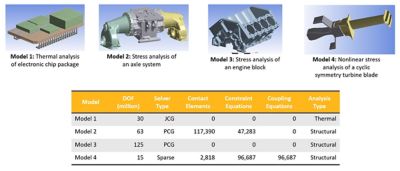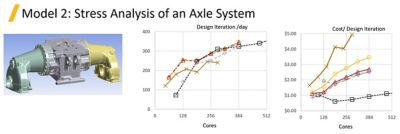-
-
Access Free Student Software
Ansys empowers the next generation of engineers
Students get free access to world-class simulation software.
-
Connect with Ansys Now!
Design your future
Connect with Ansys to explore how simulation can power your next breakthrough.
Countries & Regions
Free Trials
Products & Services
Learn
About
Back
Products & Services
Back
Learn
Ansys empowers the next generation of engineers
Students get free access to world-class simulation software.
Back
About
Design your future
Connect with Ansys to explore how simulation can power your next breakthrough.
Free Trials
ANSYS BLOG
February 14, 2024
Speed Up Your Ansys Mechanical Simulations by 10 with Ansys Gateway powered by AWS
By leveraging Ansys Gateway powered by AWS — a cloud solution designed for engineering simulation — Ansys Mechanical users can achieve up to a 10x acceleration in solution times for large simulations, compared to an average workstation.
Since Ansys Mechanical was launched over 50 years ago as Ansys’ flagship solution, we’ve witnessed some big changes in engineering simulation. Modern product development teams are creating incredibly accurate, extremely complex models that would have defied imagination in the 1970s. These models often feature very fine meshes, millions of degrees of freedom, the application of multiple physics, and the solution of both system- and component-level problems. They may also include advanced materials, transient time scales, and thousands of operating parameters.
As product development teams conduct these numerically large finite element analysis (FEA) studies, they’re pushing the limits of personal workstations and in-house computing clusters. Today more and more engineering teams are turning to high-performance computing (HPC) resources, delivered via a cloud model, to solve these large problems quickly and cost effectively. Not only do cloud solutions deliver the infinite memory needed to accommodate large FEA models, but they also provide continuous access to the most advanced chips and processors automatically.
Amplify the Benefits of Cloud with Ansys Gateway powered by AWS
As the established leader in engineering simulation, Ansys has taken the benefits of cloud computing to a new level by introducing the industry’s first cloud platform specifically built for simulation users.
Developed in partnership with Amazon Web Services (AWS), Ansys Gateway powered by AWS amplifies the performance, speed, and cost benefits of the cloud delivery model. This unique solution, available on AWS Marketplace, provides instant access to the most advanced computing resources from AWS, as well as the newest software features and functionality from Ansys.
Based on Ansys’ firsthand experience with thousands of customers, combined with technology expertise from AWS, Ansys Gateway powered by AWS delivers excellent “plug and play” performance for simulation software users. Its default virtual desktop infrastructure (VDI) settings have already been optimized to deliver significant speed and performance benefits, compared to personal workstations, in-house computing clusters, and generic cloud solutions.
However, Ansys Gateway powered by AWS also enables customized settings that help unlock the full potential of Mechanical, while also meeting specific time and cost targets. AWS offers a long list of cloud instance types that represent various combinations of central processing units (CPU), memory, storage, and networking capacity — and Ansys experts can help identify optimal instances for specific Ansys solutions and problem types.
Customized Performance for Mechanical Users
A cloud benchmarking team at Ansys recently conducted a study that proves the real-world value of Ansys Gateway powered by AWS for Mechanical users.
Since these users are studying complex, numerically large problems like vibration, acoustics, cracking and fracturing, linear and nonlinear contacts, and fatigue, they have special needs that include large amounts of memory. Lacking appropriate memory resources, their advanced FEA studies can have long solution times. But Ansys experts demonstrated the potential for a 10x acceleration in run times for a typical FEA study with more than 60 million degrees of freedom (DOF), thanks to Ansys Gateway powered by AWS.
Our new white paper, “Accelerate Large FEA Simulations by 10x with Ansys Mechanical on Ansys Gateway powered by AWS,” reports those benchmarking results in depth, but let’s take a quick look at some of the key findings.
To reflect a wide range of Mechanical applications, Ansys experts created four proprietary, in-house simulations that are not linked to any Ansys customer:
- Thermal analysis of an electronic chip package.
- Stress analysis of an axle system.
- Stress analysis of an engine block.
- Nonlinear stress analysis of a cyclic symmetry turbine blade.

Across these four simulations, the goal of the Ansys study was to maximize solver performance while also minimizing costs to the greatest extent possible. Ansys experts chose six AWS configurations, or instance types, that seemed likely to produce a good performance-to-cost ratio. These six instances feature different processors, core counts, RAM, and processing speeds.
One configuration — AWS instance Amazon EC2 hpc6id — offered the best balance of solver performance and computing cost for all four simulations. When compared to an average workstation, this instance can support up to a 10x acceleration in solution times for 60M+ DOF simulations.
Let’s look at one simulation in the study: a stress analysis of an axle system featuring 63 million DOF, as well as its contacts and constraints. For this study, the performance improvements achieved by adding cores must be balanced with an increase in RAM requirements. AWS instance hpc6id proved a good configuration for both cost and speed.
This simulation, with its large DOF count, shows the importance of choosing the right settings in Ansys Gateway powered by AWS to optimize runtimes and costs. However, it’s important to note that users can “fine-tune” their own HPC results on any AWS instance simply by varying the core count. This would depend on whether their goal is the fastest solution, the most affordable solution, or achieving a good balance between speed and cost. With Mechanical, RAM is always a critical factor and should be carefully considered in conducting performance-to-cost analysis.

Optimize Your Results via Customized Cloud Settings
The most important finding of the study? Ansys Gateway powered by AWS empowers Mechanical users to achieve optimized performance in the specific way that they define it. Mechanical users can easily customize the cloud environment for their own requirements, with upfront visibility into the costs and solve times that will be delivered by different AWS configurations.
Some product development teams may prioritize a rapid solution time based on an upcoming design milestone or launch date. They can choose an AWS instance that delivers the fastest solve time, regardless of cost. Other budget-conscious teams may select an AWS configuration that delivers a lower cost, but slower run times. Users’ configuration needs will also vary based on the Ansys solution they’re applying. In addition to our new Mechanical benchmarking study, we’ve also published white papers that focus on customizing Ansys Gateway powered by AWS for Ansys Fluent simulations and Ansys LS-DYNA models.
Intuitive, user-friendly configuration settings in the Ansys Gateway powered by AWS portal make it easy for even nonexperts to customize their settings to achieve the best possible simulation results for their own organization.
In the future, new chip or RAM solutions will impact the choices that Anys users have available, enabling them to choose new combinations of processing speed and hardware costs. But even as technology evolves, one thing is certain: As leaders in both engineering simulation and cloud computing, Ansys and AWS will always offer product development teams the ideal cloud platform for their own unique requirements. That’s the ultimate value delivered by Ansys Gateway powered by AWS.
Start realizing your own customized cost and performance benefits today by requesting a free trial of Ansys Gateway powered by AWS.